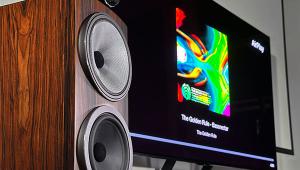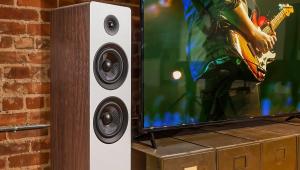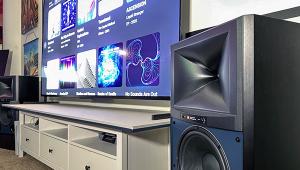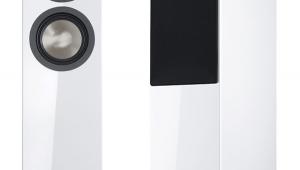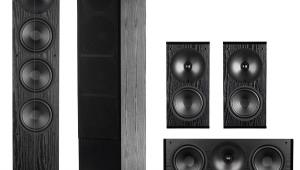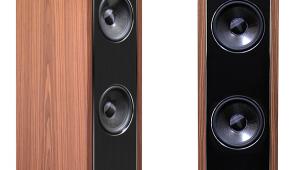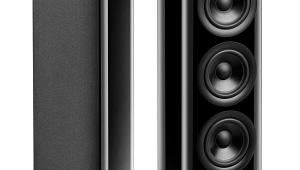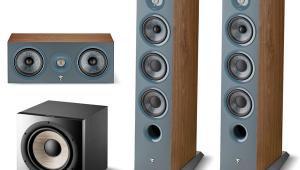Magnepan LRS Loudspeaker Review

AT A GLANCE
Plus
Extraordinary sonic transparency
Large, well-focused soundstage
Bargain-priced exotica
Minus
Requires adequate amplification
Finicky about placement
No deep bass
THE VERDICT
Magnepan's latest entry level speaker can be demanding, but it delivers compelling performance when set up properly and matched with the right gear.
Imagine that Ferrari introduced a new mid-engine sports car that sold for only $30,000. Sounds like a killer deal, but would you jump at the opportunity? The answer to that question will probably depend on your life situation. For a single person who just wants to head out and have fun, then maybe. But if you have three kids who need rides to school and soccer practice, probably not.
The Magnepan LRS (Little Ribbon Speaker) is a new model from one of the world's premier speaker brands— one that sells for an almost absurdly low price. The catch here is that the LRS won't work well in every setup and will only be a good match for certain types of listeners. More than just about any other speaker I can think of, it demands that you play matchmaker and carefully run through a personal checklist of qualities you want from a speaker. And if your priorities happen to match with the speaker's strengths, you could be headed for a level of musical nirvana way beyond what its price tag would suggest.
As one of the keystone brands of the U.S. high-end audio industry, Magnepan has been building speakers in White Bear Lake, Minnesota since it was founded by Jim Winey over 50 years ago. In the decades since then, Magnepan has remained about as doggedly a conservative company as you'll find, with the same factory and ownership for all that time, and unlike so many other iconic audio brands, there has never been even a hint that it would suddenly head off to China seeking cheaper production costs. Heck, I wouldn't be surprised if it has had the same coffee machine in the break room since the 1970s. More important, apart from a brief flirtation with a tonearm 40 years ago, Magnepan has made only dipole panel speakers for its entire history.
Magnepan's Magneplanar speakers use what's known as planar magnetic technology, and while their tall and skinny panels may bear a physical resemblance to electrostatic speakers such as those from Quad and MartinLogan, the operating principles are quite different. In some ways, a planar magnetic driver is actually more closely related to traditional cone woofers and dome tweeters than an electrostatic panel that gets plugged into the wall. They are physically similar, however, in that both types use a flat, lightweight membrane that's driven over its entire surface area, a design that eliminates the requirement of having to balance low mass and stiffness that comes with a cone or dome driver.
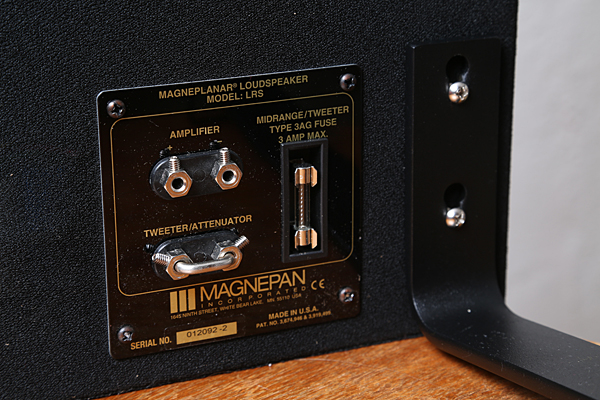
Magnepan has used three variations of the planar magnetic driver over its history. The LRS uses what it calls quasi-ribbon drivers, where a serpentine aluminum ribbon is bonded to a thin Mylar sheet that's stretched tight by the speaker's frame. This diaphragm sits immediately in front of a perforated metal plate covered with an array of magnets, so when a signal with fluctuating polarity is passed through the ribbon, it will be attracted to and repelled by the magnets, causing the panel to vibrate and move air. Despite being a two-way speaker, both the woofer and tweeter sections in the LRS reside on the same piece of Mylar membrane, with the skinnier tweeter section running vertically along one side. By keeping the tweeter section narrow, the speaker can deliver good horizontal dispersion over a wide seating area, while its 37-inch height keeps vertical dispersion tightly controlled to minimize floor and ceiling interactions.
Magnepan has offered a lower-cost entry level speaker for decades, but it has decided to target a somewhat different type of customer with this latest offering. Previous entry level Maggies like the MMGi were specifically designed to be less demanding to drive than a typical Magneplanar speaker, so customers could put together an affordable system using a simple receiver or amplifier. The LRS, in contrast, makes none of those compromises and instead represents a physical scaling-down of the full-blown Magneplanar experience. Longtime Magnepan marketing boss Wendell Diller describes the LRS as an appetizer for the line, one that's designed to suck you in with its low cost, but then entice you to move further up the Magnepan food chain.
The LRS speaker is a 48-inch-tall, 14.5-inch-wide fabric-covered panel that's just over one-inch deep. A very thin strip of wood in cherry, light oak, or black oak runs up each side to provide a visual accent to the monolithic panel, while the fabric can be ordered in off-white, gray, or black. A plate near the panel's rear side base holds speaker terminals that accept 4mm banana plugs or bare wire secured with a set screw, and Magnepan offers an optional spade lug adapter to accommodate spade connectors. The LRS has a socket to install a resistor that lowers the tweeter level slightly, with two values of resistor provided. I was happy with the speaker's sonic balance in the standard setting with no resistors installed, so didn't experiment further, but these may be useful for a reflective, bright-sounding room. Two L-shaped legs give the speaker a backward lean to make it more stable, while little folding flaps at the end of each leg provide some tilt adjustment. (More about that later.)


